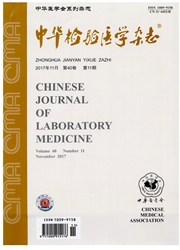

 中文摘要:
中文摘要:
目的建立同位素稀释液相色谱串联质谱法(ID—LC/MS/MS)测定血清甲状腺素的候选参考方法。方法实验性基础研究。重量法准确地称取血清或校准溶液,稀释器加入^13C6-甲状腺素,混合,除去蛋白后经过阳离子交换固相萃取柱,收集洗脱液氮气吹干,复溶后用LC/MS/MS测定甲状腺素和内标。用7种混合血清评价方法的精密度;以其中一种血清为样本,分别向样本中加入原样本浓度50%、100%和200%的标准物质评价方法的加样回收率;分别以信噪比(S/N)〉3和(S/N)〉10作为标准,评价方法的检测限和定量限。分析德国临床化学会参考物质CRM21201和CRM21202,评价方法的正确度。结果血清甲状腺素测定的批内CV和总CV分别为0.64%(0.35%~0.89%)和0.83%(0.57%-1.37%)。加样回收率为99.6%~100.7%。检测限和定量限分别为0.12和0.41nmol/L。分析CRM21201和CRM21202,测定结果与认定值的平均偏差为-0.30%(范围-0.13%~0.73%)。结论建立了ID-LC/MS/MS测定血清甲状腺素的方法,方法取样量少,测定结果正确、精密,可望作为血清甲状腺素测定的参考方法。
 英文摘要:
英文摘要:
Objective An isotope dilution liquid chromatography tandem mass spectrometric (IDLC/MS/MS) method was developed for serum total thyroxine. Methods Serum samples were sampled by weight and the 13 C6.thyroxine internal standards were added volumetrically using automated dilutors, followed by equilibration, protein precipitation, and cation exchang solid-phase extractions ( SPE ) . After SPE, the eluates were evaporated to dryness Under nitrogen and then the evaporated residues were reconstituted to prepare samples for liquid chromatography-mass spectrometry electrospray ionization (LC/MS-ESI) analysis. Seven kinds of serum pools were used to analyze the precision of the method. The analytical recovery,the limit of detection( signal to noise ratio, S/N ratio 3:1 ) and the limit of quantification (S/N ratio 10:1 )for thyroxine were calculated. Also, in order to evaluate the accuracy of this method, the candidate reference materials from German Societies for Clinical Chemistry were analyzed. Results The within-run and total coefficients of variation were :0. 64% (0. 35 %-0. 89 % )and 0. 83% (0. 57%-1.37 % ), respectively. The analytical recoveries ranged from 99. 6% to 100. 7%. The limit of detection was 0. 12 nmol/L and the limit of quantification was 0.41 nmol/L for thyroxine in human serum. The results of analyzing the reference material of CRM21201 and CRM21202 showed biases of -0. 30% (ranged from -0. 13% to 0.73% ). Conclusions A highly precise and accurate method for measuring serum total thyroxine has been developed by ID-LC/MS/MS. The method is less sample volume demand and less time-consuming and may be used as a candidate reference method.
 同期刊论文项目
同期刊论文项目
 同项目期刊论文
同项目期刊论文
 A rapid and precise method for quantification of fatty acids in human serum cholesteryl esters by li
A rapid and precise method for quantification of fatty acids in human serum cholesteryl esters by li Quantification of hemoglobin A1c by off-line HPLC separation and liquid chromatography-tandem mass s
Quantification of hemoglobin A1c by off-line HPLC separation and liquid chromatography-tandem mass s 25OHD analogues and vacuum blood collection tubes dramatically affect the accuracy of automated immu
25OHD analogues and vacuum blood collection tubes dramatically affect the accuracy of automated immu The Measurement of High-Density Lipoprotein Mediated Cholesterol Efflux from Macrophage Cells byLiqu
The Measurement of High-Density Lipoprotein Mediated Cholesterol Efflux from Macrophage Cells byLiqu 期刊信息
期刊信息
